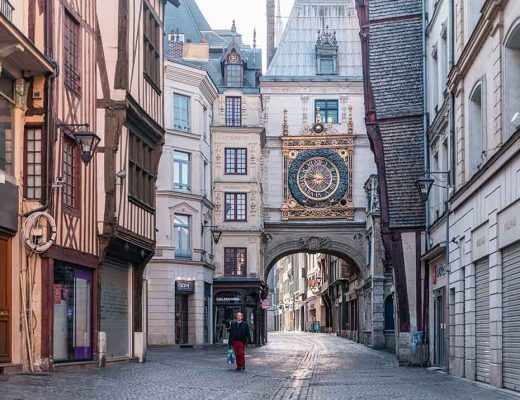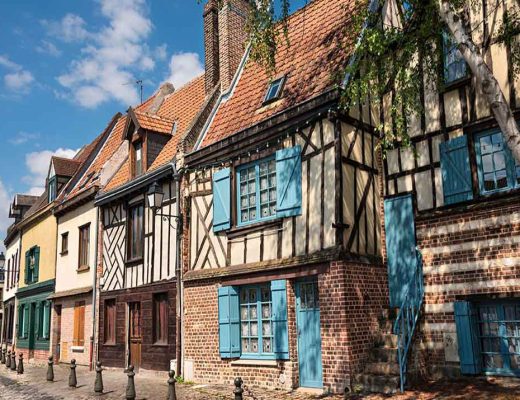I still remember the first time I stepped out of the train station in Le Mans. It was early October, the crisp air carried a gentle chill, and the trees lining the streets were painted in hues of gold, amber, and fading green. There’s something magical about this French city in autumn—it feels quieter, softer, and yet filled with the hum of history and culture waiting to be explored.
If you’ve never been to Le Mans before, it’s easy to think of it only as the city of the 24 Hours of Le Mans, the legendary car race. And yes, that event is a spectacle, but the city has much more to offer beyond the roar of engines and the scent of petrol. Its medieval heart, its quiet cafes, its museums, its warmth—Le Mans is a destination you shouldn’t just pass through, but immerse yourself in.
Over the years, I’ve built what I like to call my “Le Mans Travel Checklist”—a set of essentials I’ve refined with each visit. These aren’t just items to pack, but also mindset tips, cultural awareness notes, and practical advice for first-time travelers. My goal here is to share them with you in a way that makes your own trip not only smoother but also richer.
So here it is: my ultimate travel checklist for Le Mans in October.
1. A Reliable Pair of Walking Shoes
The medieval old town of Le Mans—Cité Plantagenêt—is the kind of place that demands exploration on foot. Cobbled streets snake uphill, half-timbered houses lean like old friends, and secret courtyards whisper with centuries of history. But walking here is not gentle; it’s uneven, often steep, and you’ll want to wander endlessly.
The first mistake I made on my inaugural trip was wearing fashionable boots with thin soles. By the end of the day, my feet were screaming, and I found myself sitting on the cathedral steps instead of soaking in the evening light on the Sarthe River.
This time, I came prepared: sturdy, cushioned walking shoes, stylish enough for France (because yes, appearances matter here), but practical. Trust me: your shoes will define your comfort level. Without them, even the most beautiful medieval alley becomes a battlefield.
Pro tip: Waterproofing spray is a lifesaver in October, when sudden rains can turn cobblestones into slick, treacherous surfaces.
2. A Layered Wardrobe for October’s Mood Swings
Early October in Le Mans is unpredictable. Mornings can feel sharp and chilly, afternoons surprisingly warm under the sun, and evenings damp again with a sudden drizzle. The key is layering.
My October wardrobe always includes:
- A lightweight thermal top for cool mornings.
- A mid-weight sweater (the kind you can pull off casually in a café).
- A waterproof jacket that doubles as wind protection.
- A scarf—practical and effortlessly French.
I remember standing outside Cathédrale Saint-Julien, watching the sunlight spill through its enormous stained glass. The morning had been icy, my breath visible, but by noon I was carrying my coat and savoring the warmth of a café crème outdoors. If I hadn’t layered, I would have either frozen or overheated.

3. A Notebook or Journal
Le Mans is a place where details matter. The sound of church bells echoing across cobblestones, the smell of fresh baguettes at a tiny boulangerie, the sudden thrill of stumbling upon a hidden garden.
I’ve found that carrying a notebook changes the way I travel. It slows me down. Instead of snapping yet another photo, I jot down how the light hit the cathedral spires, or how an old man on a bicycle smiled at me as he passed.
This small ritual turned my visits into living memories rather than just a gallery of digital images. If you’re the kind of traveler who wants to feel the soul of a place, bring a journal. In years to come, those scribbles will feel more vivid than a thousand forgotten photos.
4. The Courage to Wander Off-Script
Le Mans isn’t Paris or Lyon. There’s no single “must-see” checklist here that will impress your Instagram followers. And that’s its strength.
On one visit, I took a wrong turn near the Jardin des Plantes and ended up in a quiet residential street. There was no tourist sign, no attraction, just a row of simple houses with flowers spilling over their fences. A woman opened her shutters and waved at me, as if I were an expected guest. That moment was as precious as standing inside the cathedral.
So here’s what I tell every first-timer: yes, plan to see the cathedral, the racing museum, and the old town. But leave space—whole afternoons—for wandering. The best memories in Le Mans happen when you let the city surprise you.
5. A Camera That Excels in Low Light
October in Le Mans means shorter days, long twilights, and soft, romantic evenings. The medieval old town, lit by golden lanterns, feels like a movie set. But it’s also a photographer’s challenge.
Phone cameras often struggle in low light. If photography matters to you, bring something capable of capturing detail in dim settings. Some of my favorite photos were taken just as night fell—cobblestones glowing, shutters closed, and a faint mist curling from the river.
And don’t just photograph the “big sights.” Capture the details: the crooked beams of a timbered house, the reflection of stained glass on a stone floor, the way a café sign swings in the wind.
6. A Taste for Local Cuisine
Le Mans is in Sarthe, a region proud of its gastronomy. If you only come for the race and miss the food, you’ve missed half the story.
Here’s what I always put on my Le Mans food checklist:
- Rillettes de Porc: A rich, rustic pork spread that’s practically the city’s culinary emblem. Spread it on warm bread, and you’ll never forget it.
- Poulet de Loué: A famous local chicken, tender and full of flavor. Order it roasted if you see it on the menu.
- Local wines: The Loire Valley isn’t far, and Le Mans offers an excellent chance to taste regional whites and reds.
One rainy October night, I ducked into a tiny bistro with fogged-up windows. I ordered rillettes and a glass of red wine, and the warmth of that meal remains one of my clearest memories.
Practical note: For booking restaurants in France, I often use LaFourchette (TheFork)—a reliable platform to find, reserve, and sometimes even get discounts at local restaurants.
7. The Curiosity to Learn Le Mans’ History
Too many people reduce Le Mans to the famous 24-hour race. But the city is a medieval jewel, and if you arrive without a thirst for history, you’re missing its heartbeat.
The Cité Plantagenêt was home to the Plantagenet dynasty, whose members shaped European history. Walking here feels like stepping into a living museum. The Cathédrale Saint-Julien is one of France’s largest, with a mix of Romanesque and Gothic styles, and the stained glass rivals even Chartres.
If you want to go deeper, visit the Musée de Tessé, where art and history mingle, or the Carré Plantagenêt, a museum dedicated to the city’s archaeology.
A good guidebook or a downloaded audio guide helps. I like using GetYourGuide to book local walking tours—there’s something special about having a guide explain how the Plantagenets once ruled from this very ground.
8. A Flexible Itinerary
Le Mans is a city where rushing makes no sense. Things close for long lunches, the weather changes suddenly, and sometimes, you’ll stumble across an event you didn’t expect.
Once, I wandered into the cathedral square only to find an impromptu choir performing. Another time, a street market filled the air with music and laughter. If I’d been obsessed with sticking to my plan, I would have missed these moments.
So my checklist includes flexibility. Plan your essentials, yes. But leave mornings or afternoons open. That’s when the serendipity happens.
9. A Base That Feels Like Home
Accommodation in Le Mans ranges from charming B\&Bs in the old town to modern hotels near the station. The key is choosing one that matches your rhythm.
When I want atmosphere, I stay in the medieval quarter—waking up to cobblestones and church bells feels timeless. When I need convenience, I book near the station for easy train access.
For bookings, I usually rely on Booking.com or Airbnb for variety, and sometimes Expedia when I’m pairing flights with stays. The trick is to book early in October: while it’s quieter than summer, Le Mans still hosts plenty of autumn events.
10. An Awareness of French Pace
If it’s your first time in France, Le Mans will introduce you to a rhythm of life that’s different from other parts of Europe. Shops close for long lunches. Dinner starts later than you might expect. Cafés are places to linger, not to rush.
At first, this pace frustrated me. I wanted to tick boxes, see everything, move quickly. But the more I leaned into it, the more rewarding the trip became.
Now, I bring patience as part of my travel checklist. It’s intangible, yes, but essential. Travel isn’t just about sights; it’s about absorbing a way of life. And Le Mans’ way is unhurried, thoughtful, steeped in tradition.

11. Tickets and Transport Sorted in Advance
If you’re planning to visit any major site or catch a special exhibit, book your tickets ahead of time. Even in October, popular spots like the 24 Hours of Le Mans Museum can attract crowds.
I often use Omio for booking train tickets across France and Europe—it’s user-friendly and keeps all reservations in one place. For attractions, platforms like Tiqets and GetYourGuide have proven reliable.
Le Mans is also part of the TGV network, which means you can be in Paris in under an hour. That makes it a perfect weekend detour, but it also means trains fill up fast. Don’t assume you can just show up at the station.
12. An Openness to Seasonal Charm
October is not peak season in Le Mans, and that’s precisely why I love it. The city feels lived-in rather than staged. Locals aren’t overwhelmed by tourists, and you get a truer sense of daily life.
I’ve walked through the medieval streets in October evenings when fog clung to the riverbanks, making the city feel like a dream. I’ve sipped hot chocolate in near-empty cafés where the only sound was rain against the glass.
Bring an openness to these quieter, moodier moments. They’re not always postcard-perfect, but they reveal the soul of Le Mans.
Le Mans in October is a city of contrasts: medieval yet modern, lively yet serene, grand yet intimate. My checklist isn’t just about packing the right jacket or downloading the right app; it’s about preparing yourself to meet the city on its own terms.
If you come with sturdy shoes, a layered wardrobe, a hungry heart, and a willingness to slow down, you’ll find Le Mans gives back far more than you expect. It’s not a city that shouts for attention—it whispers, waits, and rewards those who listen.
And in the quiet glow of an October evening, as the cathedral bells ring and the streets grow still, you’ll realize something simple yet profound: you didn’t just visit Le Mans. You lived it.



